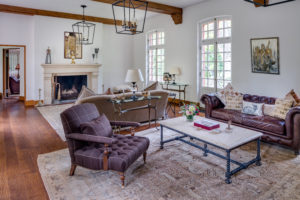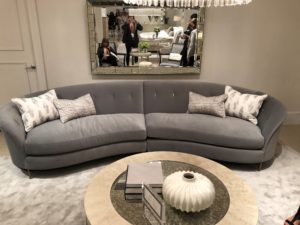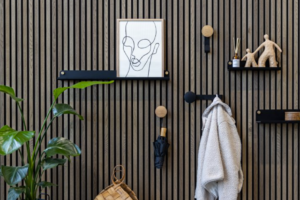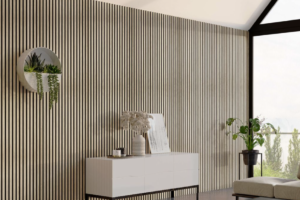 When someone describes their house as traditional, what do you think of? For me, it brings to mind an older home filled with an assortment of family antiques, an overload of floral patterns, ornately carved wood, and deep red oriental rugs. We don’t think of a traditional home as a place for a millennial, or even a middle-aged couple who enjoys design. If we broaden our perspective and let historical styles inform our decorating choices rather than dictate them, we can enjoy a style I call “New Traditional.” Much of great design looks to the past for inspiration. We can borrow from the styles of the great homes of the English countryside or sophisticated Parisian apartments, but then tweak, trim, and change the color palette…and now it feels inventive.
When someone describes their house as traditional, what do you think of? For me, it brings to mind an older home filled with an assortment of family antiques, an overload of floral patterns, ornately carved wood, and deep red oriental rugs. We don’t think of a traditional home as a place for a millennial, or even a middle-aged couple who enjoys design. If we broaden our perspective and let historical styles inform our decorating choices rather than dictate them, we can enjoy a style I call “New Traditional.” Much of great design looks to the past for inspiration. We can borrow from the styles of the great homes of the English countryside or sophisticated Parisian apartments, but then tweak, trim, and change the color palette…and now it feels inventive.
What I’m seeing a lot of in the furniture marketplace is a look back to traditional styles but with a streamlined interpretation. Gone are sofas with oversized rolled arms that were super popular in the 1980’s. Gone are most skirted sofas. Chesterfield and scoop-armed sofas look classic…almost, dare I say it, “modern.” We want our rooms to look light and open. The New Traditionalism pays homage to old styles, but gives them a lighter, streamlined twist. This makes traditional styles feel updated. Restoration Hardware understands this balance and has justifiably become one of the most popular furniture retailers of the 21st century.
These are some of the things I’m seeing in my travels:
Channeled Upholstery – think Paris in the 1920’s. Art Deco is classic and modern at the same time. Pair that sofa with a tufted leather chair and little brass bunching tables where you can place candles, bowls of nuts, and a small platter of brie for a stylish cocktail party. Of course, martinis and a piano player would really complete the vibe.
 Curved Sofas – also a style born in the Deco 20’s. These can be tailored and restrained or sinewy and sexy. A curved sofa is wonderful for conversation as you’re slightly turned towards the person with whom you’re sitting. Bear in mind, a curved sofa needs to be floating in a room – not up against a wall. Therefore, not all rooms can accommodate them. If you have one but it’s looking flat, you can add foam inserts to breathe life into them.
Curved Sofas – also a style born in the Deco 20’s. These can be tailored and restrained or sinewy and sexy. A curved sofa is wonderful for conversation as you’re slightly turned towards the person with whom you’re sitting. Bear in mind, a curved sofa needs to be floating in a room – not up against a wall. Therefore, not all rooms can accommodate them. If you have one but it’s looking flat, you can add foam inserts to breathe life into them.
Simple drapery panels – I’ve been removing swags from lots of houses lately and replacing them with simple drapes. The fabrics are solids or soft patterns and most often hung on slim metal rods. The rods are shedding their ornate finials– just use an endcap or a French return. The key word in draperies is simple.
Traditional fabrics and wallcoverings in lighter, softer colors – damask and toile done in soft slate and butter yellow or green and brown. Just changing the colors gives these traditional styles a modern outlook. Also, look closely at some toile fabrics: Some are telling stories of urban challenges instead of French and English royalty.
Black metal window frames – these are being used in both traditional and contemporary homes and are also popular for shower enclosures.
High gloss paint on interior woodwork – this is not for the DIYer. To get the best effect, it must be done with oil-based paint and several coats have to be applied. The paint has to be sanded in between coats to create the ultimate shine. The drying time is longer than latex paint, but for a room with important moldings, the effect is worth the hassle.
Bamboo motifs – the Chippendale–style is more than just ball and claw feet. Inspired by Chinese design, it includes using faux bamboo for furniture and mirrors. This is a classic that mixes well in traditional and modern homes.
The bottom line – just have fun. The New Traditionalism gives you permission to mix and match. Use your mom’s camp trunk as a side table next to a slipcovered boho sofa. Hang some pictures. Grab a vintage flat-weave rug and a weathered leather chair. Most importantly, remember to put your feet up and get comfortable!







